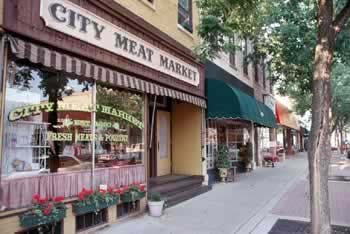|
How Can I Find and Help Build
a Walkable Community - continued
Walkability Items to be rated are always on a scale. A
1-10 scale can be personalized and applied to each of the
below twelve categories. Common sense and powers of observation
are used to make these determinations. The categories are
in no particular order. Never pick a town that you have not
visited. Always ask for second and third opinions.
If I were making a commitment to move to a town I would want
the town to have high scores on 6 or more of the following
12 categories:
Walkable Communities Have:
|
|
1. Intact town centers. This center
includes a quiet, pleasant main street with a hearty,
healthy set of stores. These stores are open for business
a minimum of 8 hours a day. The stores include things
like barbers/beauticians, hardware, druggist, small
grocery/deli, sets of good restaurants, clothing, variety
store, ice cream shop, stores that attract children,
many youth and senior services, places to conduct civic
and personal business, library, all within a 1/4 mile
walk (5 minutes) of the absolute center. If this is
a county seat, the county buildings are downtown. If
this is an incorporated town the town hall is in the
town center. The library is open for business at least
10 hours a day 6-7 days a week. There is still a post
office downtown. |
 |
|
 |
2. Residential densities, mixed income, mixed
use. Near the town center, and in a large town
at appropriate transit locations there will be true
neighborhoods. Higher densities are toward the town
center and in appropriate concentrations further out.
Housing includes mixed income and mixed use. A truly
walkable community does not force lots of people to
drive to where they work. Aspen, for example, is a great
place to shop and play...but fails to provide housing
for anyone who works there. Granny flats, design studios
and other affordable housing are part of the mix in
even the wealthiest neighborhoods. |
|
|
3. Public Space. There are many
places for people to assemble, play and associate with
others within their neighborhood. The best neighborhoods
have welcoming public space within 1/8th mile (700 feet)
of all homes. These spaces are easily accessed by all
people.
4. Universal Design. The community
has a healthy respect for people of all abilities, and
has appropriate ramps, medians, refuges, crossings of
driveways, sidewalks on all streets where needed, benches,
shade and other basic amenities to make walking feasible
and enjoyable for everyone. |
 |
|
Previous | 1
| 2 | 3 | 4
| 5 | 6 |
Next
|
Walkable
Communities.,
33 E. Pine Street, Orlando, FL 32801 (866) 347-2734
For any comments, questions or suggestions about the content of
this web site please email: Ken Owens
Last Updated:
April 22, 2005
|
|



